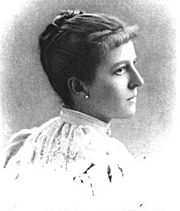Helen Abbott Michael facts for kids
Helen Cecilia De Silver Abbott Michael (December 23, 1857 – November 29, 1904) was an American scientist. She was one of the first to study how the chemicals in plants relate to their growth and different types. Helen believed that changes in a plant's chemical makeup as it grew could show how evolution works. She also studied at Tufts University and Harvard University. She worked with and later married a famous organic chemist named Arthur Michael.
Contents
Helen Abbott Michael's Early Life and Education
Helen Cecilia De Silver Abbott was born in Philadelphia in 1857. Her parents were James Abbott and Caroline Montelius. Helen first loved music and studied to be a pianist. She even performed in Paris.
From Music to Science: A New Path
In 1881, Helen returned to America. She bought a book called Treatise on Physiological Optics by Hermann von Helmholtz. This book sparked her interest in science. She became very interested in optics, physics, and zoology.
Studying Medicine and Plant Chemistry
By the fall of 1882, Helen decided to study medicine. She joined the Woman's Medical College of Pennsylvania. Her family's wealth helped her study with well-known doctors. During her second year, she had to leave due to an injury.
While recovering, Helen became interested in research. She focused on the chemical analysis of plants. After some children got sick from eating poisonous roots, she wanted to learn more. She studied the chemical properties of plants on her own. She also traveled and used her family's connections to learn more.
Scientific Research and Discoveries
In the summer of 1887, Helen traveled through Europe. She visited many scientists and learned about higher education for women. She went to labs in Sweden, Switzerland, Germany, and Britain. Scientists welcomed her because she had a letter from Samuel Langley, who was the secretary of the Smithsonian Institution.
Collaborating with Arthur Michael
Helen returned to America in late 1887. She started research in Boston. She worked with Professor Henry Trimble and later with Professor Arthur Michael at Tufts University. She married Arthur Michael in 1888.
Soon after their wedding, they traveled the world. They explored many different cultures. In 1890, they came back to America. Arthur became the director of the Chemical Laboratory at Clark University in Worcester.
Research in England and Sugar Molecules
In 1891, Helen and Arthur moved to Bonchurch, England. This town is on the Isle of Wight. They did chemical research in their own private lab for several years. Helen wrote four papers about synthetic organic chemistry from this lab.
When they returned to the United States, Helen began studying sugar molecules. In 1895, she gave a talk at the Franklin Institute. She reviewed how sugars were made in labs.
Later Life and Legacy
Helen Abbott Michael returned to studying medicine in 1900. She went to the Tufts University School of Medicine. She earned her M.D. degree in June 1903.
Helping Others and Final Days
After becoming a doctor, Helen opened a hospital for people who could not afford care. She practiced medicine there. Sadly, she died the next year in 1904. She caught influenza from one of her patients. She was buried in Laurel Hill Cemetery in Philadelphia.
Helen's Important Predictions
Helen Michael gave a lecture called "Plant Analysis as an Applied Science." In it, she predicted that future chemists would be able to create food. She thought they could make proteins, sugars, and starches needed for humans. She also believed that changes in a plant's chemical makeup as it grew showed how the theory of evolution worked.
Activities and Honors
Helen Abbott Michael was a member of several important scientific groups:
- American Philosophical Society (1887)
- American Association for the Advancement of Science
- Franklin Institute of Philadelphia
- Deutsche Chemische Gesellschaft (Berlin)
See also


